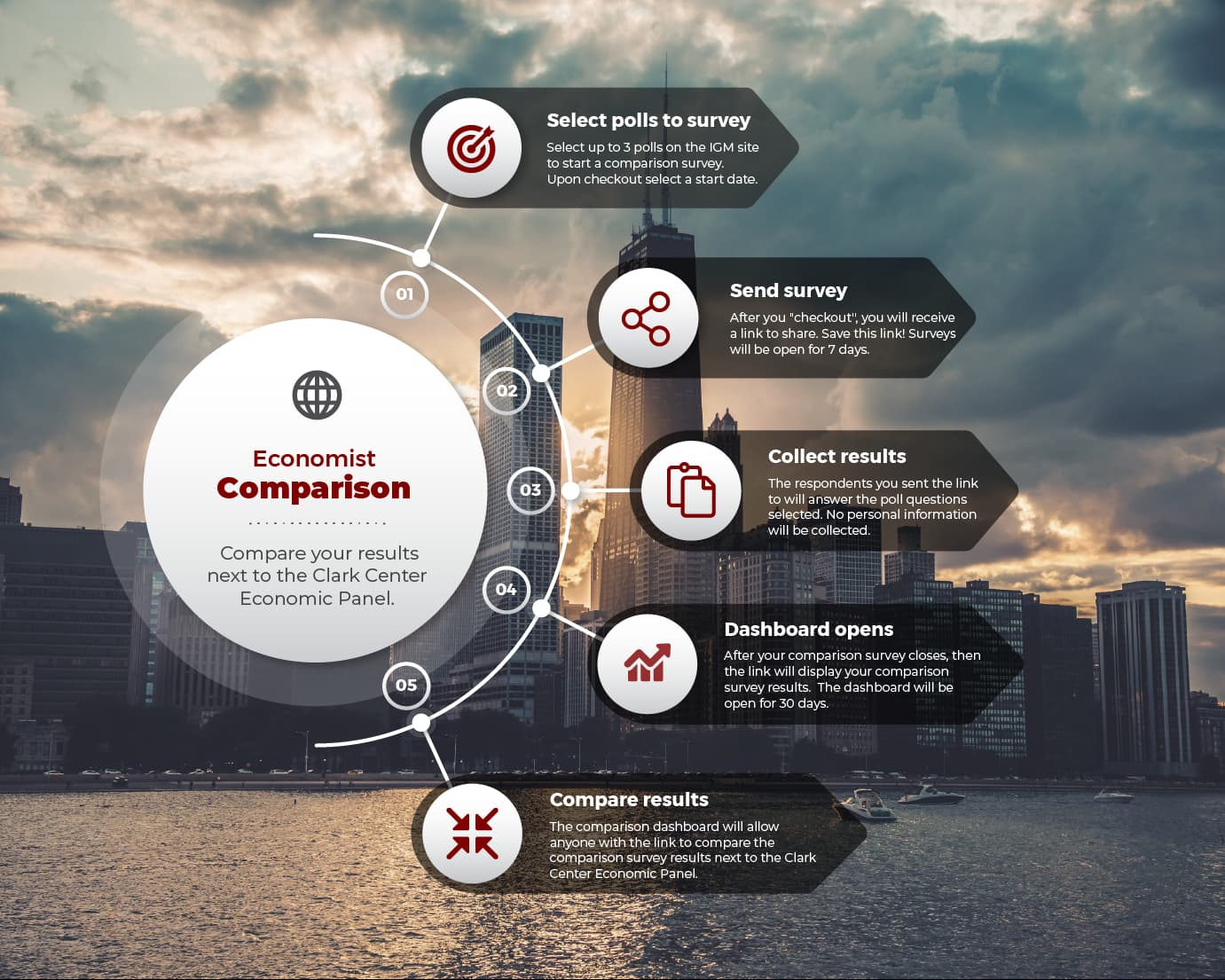Question A:
Public companies that pursue social and environmental initiatives bear no measurable costs (in terms of lower profits) relative to similar companies that do not pursue such initiatives.
Responses
© 2025. Kent A. Clark Center for Global Markets.
10%
0%
21%
38%
26%
5%
0%
Responses weighted by each expert's confidence
© 2025. Kent A. Clark Center for Global Markets.
28%
43%
24%
5%
0%
Question B:
Public companies that pursue social and environmental initiatives benefit from a measurably lower cost of capital than similar companies that do not pursue such initiatives.
Responses
© 2025. Kent A. Clark Center for Global Markets.
10%
3%
5%
13%
49%
21%
0%
Responses weighted by each expert's confidence
© 2025. Kent A. Clark Center for Global Markets.
7%
16%
55%
21%
0%
Question C:
There are substantial social benefits when managers of public companies make choices that account for the impact of their decisions on customers, employees, and community members beyond the effects on shareholders.
Responses
© 2025. Kent A. Clark Center for Global Markets.
10%
3%
3%
13%
21%
46%
5%
Responses weighted by each expert's confidence
© 2025. Kent A. Clark Center for Global Markets.
3%
15%
24%
50%
9%
Question A Participant Responses
Participant |
University |
Vote |
Confidence |
Bio/Vote History |
|---|---|---|---|---|
 John Campbell |
Harvard | Bio/Vote History | ||
|
This is unlikely on prior grounds (free lunches are very rare), although evidence is scarce.
|
||||
 John Cochrane |
Hoover Institution Stanford | Bio/Vote History | ||
|
By definition, no? The definition of pursuing such initiatives is, "beyond the point of profit maximization." Corporations are darn clean and responsible on their own, just to maximize profits. But that's not the usual meaning of initiatives.
|
||||
 Francesca Cornelli |
Northwestern Kellogg | Bio/Vote History | ||
|
Depending on the strategy followed and the industry taken the effect can be positive or negative
|
||||
 Douglas Diamond |
Chicago Booth | Bio/Vote History | ||
|
|
||||
 Wenxin Du |
HBS | Bio/Vote History | ||
|
|
||||
 Darrell Duffie |
Stanford | Bio/Vote History | ||
|
I assume an "ESG" marketing objective for some types of firms. To maximize equity market value, some such firms are probably wiling to incur ESG-related costs in order to increase demand for their products and services, resulting in little or no overall profit disadvantage.
|
||||
 Janice Eberly |
Northwestern Kellogg | Did Not Answer | Bio/Vote History | |
|
|
||||
 Eugene Fama |
Chicago Booth | Bio/Vote History | ||
|
There may be special cases where this is true, but the question implies always.
|
||||
 Xavier Gabaix |
Harvard | Did Not Answer | Bio/Vote History | |
|
|
||||
 Itay Goldstein |
UPenn Wharton | Bio/Vote History | ||
|
|
||||
 John Graham |
Duke Fuqua | Bio/Vote History | ||
|
|
||||
 Campbell R. Harvey |
Duke Fuqua | Bio/Vote History | ||
|
The "E" can be the most costly. "S" may also be costly. "G" is not clear. For example, a company voluntarily offset carbon by purchasing credits is a clear cost. There might be benefits both to stakeholders and public - but it is a cost.
|
||||
 Harrison Hong |
Columbia | Bio/Vote History | ||
|
|
||||
 Wei Jiang |
Emory Goizueta | Bio/Vote History | ||
|
|
||||
 Steven Kaplan |
Chicago Booth | Bio/Vote History | ||
|
Some companies destroy value while some increase value. The devil is in the details.
|
||||
 Anil Kashyap |
Chicago Booth | Bio/Vote History | ||
|
Look at the asset management companies as an example of some downside risks. In Europe it is very different. Hard to generalize.
|
||||
 Ralph Koijen |
Chicago Booth | Bio/Vote History | ||
|
|
||||
 Camelia Kuhnen |
UNC Kenan-Flagler | Bio/Vote History | ||
|
|
||||
 Andrew Lo |
MIT Sloan | Did Not Answer | Bio/Vote History | |
|
|
||||
 Michelle Lowry |
Drexel LeBow | Bio/Vote History | ||
|
Managers focus on maximizing shareholder value. They choose to invest in those social and environmental issues that have positive (or at least nonnegative) effects on shareholder value.
|
||||
 Sydney Ludvigson |
NYU | Bio/Vote History | ||
|
|
||||
 Matteo Maggiori |
Stanford GSB | Bio/Vote History | ||
|
There are good or bad projects. If they pursue bad (low or negative NPV) projects purely to achieve a label on ESG the costs would be measurable. If they pursue good projects, which might include many with ESG orientation, then they would stand to gain.
|
||||
 Gregor Matvos |
Northwestern Kellogg | Did Not Answer | Bio/Vote History | |
|
|
||||
 Tobias Moskowitz |
Yale School of Management | Bio/Vote History | ||
|
Constraints have to reduce optimal profits. Just depends how binding they are.
|
||||
 Stefan Nagel |
Chicago Booth | Bio/Vote History | ||
|
|
||||
 Jonathan Parker |
MIT Sloan | Bio/Vote History | ||
|
In theory this could go either way. And there is little data and variation from which to measure causality, and there are a lot of papers, with different findings and methods (and shortcomings) so we just don't know yet.
|
||||
 Christine Parlour |
Berkeley Haas | Bio/Vote History | ||
|
Firms are adding an extra constraint.
|
||||
 Thomas Philippon |
NYU Stern | Bio/Vote History | ||
|
|
||||
 Manju Puri |
Duke Fuqua | Bio/Vote History | ||
|
|
||||
 Michael R. Roberts |
UPenn Wharton | Bio/Vote History | ||
|
Difficult question to answer empirically and not sufficiently familiar with literature.
|
||||
 Paola Sapienza |
Hoover Institution Stanford | Bio/Vote History | ||
|
It really depends. Sometime firms embrace into these initiatives as marketing devices, then they do not conflict with profits. sometime they do not. distinguishing between the two cases will be essential. Firms may cater to employees and consumers increasing profits, or not.
-see background information here |
||||
 Amit Seru |
Stanford GSB | Bio/Vote History | ||
|
|
||||
 Robert Stambaugh |
UPenn Wharton | Bio/Vote History | ||
|
|
||||
 Laura Starks |
UT Austin McCombs | Bio/Vote History | ||
|
This question cannot be addressed so simply - it depends on the context. For example, are profits here being measured over the ST or LT? Do the initiatives attract customers or talented employees or do they allay regulatory risks? There are no simple answers here.
-see background information here |
||||
 Jeremy Stein |
Harvard | Bio/Vote History | ||
|
|
||||
 Johannes Stroebel |
NYU Stern | Bio/Vote History | ||
|
|
||||
 Sheridan Titman |
UT Austin McCombs | Bio/Vote History | ||
|
|
||||
 Stijn Van Nieuwerburgh |
Columbia Business School | Bio/Vote History | ||
|
Putting constraints on problems reduces cash flows because the negative externalities are untaxed.
|
||||
 Toni Whited |
UMich Ross School | Bio/Vote History | ||
|
|
||||
Question B Participant Responses
Participant |
University |
Vote |
Confidence |
Bio/Vote History |
|---|---|---|---|---|
 John Campbell |
Harvard | Bio/Vote History | ||
|
There is a modest negative effect of "greenness" on the cost of capital. To measure it, it is important to use forward-looking measures of expected returns.
-see background information here |
||||
 John Cochrane |
Hoover Institution Stanford | Bio/Vote History | ||
|
Cost of capital is the return to shareholders and bondholders. Even lower profits can just mean lower price. Nobody but governments cut your interest rate for fashionable virtue. Only if a substantial number of investors basically want to make a charitable contribution, doubtful
|
||||
 Francesca Cornelli |
Northwestern Kellogg | Bio/Vote History | ||
|
ESG indexes often lower the cost of capital
|
||||
 Douglas Diamond |
Chicago Booth | Bio/Vote History | ||
|
|
||||
 Wenxin Du |
HBS | Bio/Vote History | ||
|
|
||||
 Darrell Duffie |
Stanford | Bio/Vote History | ||
|
Theoretically, the effect is not zero but small (e.g. Berk and van Binsbergen, 2024). If there is literally no effect, however, then issuances and marketing of green bonds have been an irrational waste of effort. Some investors clearly want to buy green securities.
-see background information here |
||||
 Janice Eberly |
Northwestern Kellogg | Did Not Answer | Bio/Vote History | |
|
|
||||
 Eugene Fama |
Chicago Booth | Bio/Vote History | ||
|
I think Pastor and Stambaugh come to the opposite conclusion for the general case.
|
||||
 Xavier Gabaix |
Harvard | Did Not Answer | Bio/Vote History | |
|
|
||||
 Itay Goldstein |
UPenn Wharton | Bio/Vote History | ||
|
|
||||
 John Graham |
Duke Fuqua | Bio/Vote History | ||
|
|
||||
 Campbell R. Harvey |
Duke Fuqua | Bio/Vote History | ||
|
It is possible that some investors might favor the ESG company increasing stock prices and this might slightly reduce their cost of capital. However, it is very difficult to measure. Indeed, we don't even know what the true cost of capital is for a particular company..
|
||||
 Harrison Hong |
Columbia | Bio/Vote History | ||
|
|
||||
 Wei Jiang |
Emory Goizueta | Bio/Vote History | ||
|
|
||||
 Steven Kaplan |
Chicago Booth | Bio/Vote History | ||
|
It depends on the extent to which those activities are value increasing versus value decreasing.
|
||||
 Anil Kashyap |
Chicago Booth | Bio/Vote History | ||
|
|
||||
 Ralph Koijen |
Chicago Booth | Bio/Vote History | ||
|
At least, as perceived by companies
-see background information here |
||||
 Camelia Kuhnen |
UNC Kenan-Flagler | Bio/Vote History | ||
|
|
||||
 Andrew Lo |
MIT Sloan | Did Not Answer | Bio/Vote History | |
|
|
||||
 Michelle Lowry |
Drexel LeBow | Bio/Vote History | ||
|
Investing in these initiatives decreases risk, in ways that can lower cost of capital.
|
||||
 Sydney Ludvigson |
NYU | Bio/Vote History | ||
|
Very little work on this, but there is at least one study finding that the "perceived cost of capital has dropped substantially for green firms relative to brown firms"
-see background information here |
||||
 Matteo Maggiori |
Stanford GSB | Bio/Vote History | ||
|
I have not seen super reliable evidence on this. Estimating the cost of capital is notoriously difficult. Also the "benefits" might have been transitory from a moment when investors paid more attention to ESG labels.
|
||||
 Gregor Matvos |
Northwestern Kellogg | Did Not Answer | Bio/Vote History | |
|
|
||||
 Tobias Moskowitz |
Yale School of Management | Bio/Vote History | ||
|
We do not know if there is a measurable impact on the cost of capital.
|
||||
 Stefan Nagel |
Chicago Booth | Bio/Vote History | ||
|
|
||||
 Jonathan Parker |
MIT Sloan | Bio/Vote History | ||
|
There are tax benefits, but in terms of pre-tax returns, in theory this could go either way. And with little time series data, there is little evidence on this point. As a result, papers come up with different findings, with different methods and shortcomings.
|
||||
 Christine Parlour |
Berkeley Haas | Bio/Vote History | ||
|
Cost of capital is determined by the capital markets.
|
||||
 Thomas Philippon |
NYU Stern | Bio/Vote History | ||
|
|
||||
 Manju Puri |
Duke Fuqua | Bio/Vote History | ||
|
|
||||
 Michael R. Roberts |
UPenn Wharton | Bio/Vote History | ||
|
I believe their may be short-run effects - conditional - but unclear if their are long-run effects - unconditional.
|
||||
 Paola Sapienza |
Hoover Institution Stanford | Bio/Vote History | ||
|
Again it depends what is the effects on the firm. Firms seem pretty smart at selecting goals that improve traffic especially from aligned consumers.
|
||||
 Amit Seru |
Stanford GSB | Bio/Vote History | ||
|
|
||||
 Robert Stambaugh |
UPenn Wharton | Bio/Vote History | ||
|
|
||||
 Laura Starks |
UT Austin McCombs | Bio/Vote History | ||
|
Again it depends on the purpose of the initiatives and their outcomes. It also depends on the preferences of the shareholders and debtholders. For further discussion on these issues see link.
-see background information here |
||||
 Jeremy Stein |
Harvard | Bio/Vote History | ||
|
|
||||
 Johannes Stroebel |
NYU Stern | Bio/Vote History | ||
|
Depends on the activities. Activities to mitigate climate risk likely do affect cost of capital, though estimates of effect size vary widely.
-see background information here |
||||
 Sheridan Titman |
UT Austin McCombs | Bio/Vote History | ||
|
|
||||
 Stijn Van Nieuwerburgh |
Columbia Business School | Bio/Vote History | ||
|
Green (ESG) firms earn negative alphas, their firms have lower costs of capital. the opposite is true for brown firms.
-see background information here |
||||
 Toni Whited |
UMich Ross School | Bio/Vote History | ||
|
|
||||
Question C Participant Responses
Participant |
University |
Vote |
Confidence |
Bio/Vote History |
|---|---|---|---|---|
 John Campbell |
Harvard | Bio/Vote History | ||
|
It is true that there are negative externalities that can be ameliorated by socially conscious decisions of corporate managers; however, a broad mandate can also empower managers to pursue their own objectives, harming shareholders without compensating benefits to stakeholders.
|
||||
 John Cochrane |
Hoover Institution Stanford | Bio/Vote History | ||
|
Wiggle room in the wording. Companies that trash the environment, sell terrible products, offend community, mistreat workers, don't make money. Pure profit maximizers do all that. Beyond that, corporations are a terrible vehicle for social change.
|
||||
 Francesca Cornelli |
Northwestern Kellogg | Bio/Vote History | ||
|
If the right strategy is followed and the correct social benefits are targeted that is true
|
||||
 Douglas Diamond |
Chicago Booth | Bio/Vote History | ||
|
|
||||
 Wenxin Du |
HBS | Bio/Vote History | ||
|
|
||||
 Darrell Duffie |
Stanford | Bio/Vote History | ||
|
Some firms do significant good for others without much cost to equity value. [At a value-maximizing strategy, there is a small marginal effect on value of a change in strategy that could have a large marginal benefit for other stakeholders (first order condition).]
|
||||
 Janice Eberly |
Northwestern Kellogg | Did Not Answer | Bio/Vote History | |
|
|
||||
 Eugene Fama |
Chicago Booth | Bio/Vote History | ||
|
|
||||
 Xavier Gabaix |
Harvard | Did Not Answer | Bio/Vote History | |
|
|
||||
 Itay Goldstein |
UPenn Wharton | Bio/Vote History | ||
|
|
||||
 John Graham |
Duke Fuqua | Bio/Vote History | ||
|
|
||||
 Campbell R. Harvey |
Duke Fuqua | Bio/Vote History | ||
|
In certain special situations, there may be some social benefit -it is not "substantial". Overall, it is best to focus on the residual stakeholder (equity holders). Assuming a robust corporate governance, good news for equity should spillover to all stakeholders.
|
||||
 Harrison Hong |
Columbia | Bio/Vote History | ||
|
|
||||
 Wei Jiang |
Emory Goizueta | Bio/Vote History | ||
|
|
||||
 Steven Kaplan |
Chicago Booth | Bio/Vote History | ||
|
I continue to believe that Milton Friedman was right over 50 years ago. The socially best path for a company and society is for companies to take actions that maximize their long-term shareholder value.
|
||||
 Anil Kashyap |
Chicago Booth | Bio/Vote History | ||
|
It can go both ways
|
||||
 Ralph Koijen |
Chicago Booth | Bio/Vote History | ||
|
|
||||
 Camelia Kuhnen |
UNC Kenan-Flagler | Bio/Vote History | ||
|
|
||||
 Andrew Lo |
MIT Sloan | Did Not Answer | Bio/Vote History | |
|
|
||||
 Michelle Lowry |
Drexel LeBow | Bio/Vote History | ||
|
Companies might choose to make investments that had zero NPV, but provided social benefits to employees, the environment, etc. If this is the case, these stakeholders would be better off
|
||||
 Sydney Ludvigson |
NYU | Bio/Vote History | ||
|
enormous potential positive externalities, but firms have in recent decades have limited incentives to internalize them
|
||||
 Matteo Maggiori |
Stanford GSB | Bio/Vote History | ||
|
There are many externalities (pecuniary, demand, environmental, national security). It is often the role of the government to make managers (and other actors) internalize the externalities (regulation, tariffs, etc...)
|
||||
 Gregor Matvos |
Northwestern Kellogg | Did Not Answer | Bio/Vote History | |
|
|
||||
 Tobias Moskowitz |
Yale School of Management | Bio/Vote History | ||
|
Not aware of evidence showing this or even how to measure it.
|
||||
 Stefan Nagel |
Chicago Booth | Bio/Vote History | ||
|
But it's a matter of degree. For example, I agree with regards to adherence to fundamental ethical principles.
|
||||
 Jonathan Parker |
MIT Sloan | Bio/Vote History | ||
|
Just very unclear at this point. In a competitive economy without externalities, this is false. More realistically, it might help, but it might just burn resources and so harm. Equilibrium effects are hard to know, and corporate decisionmakers have little understanding of them.
|
||||
 Christine Parlour |
Berkeley Haas | Bio/Vote History | ||
|
Stakeholder benefits are measured in social benefits
|
||||
 Thomas Philippon |
NYU Stern | Bio/Vote History | ||
|
|
||||
 Manju Puri |
Duke Fuqua | Bio/Vote History | ||
|
|
||||
 Michael R. Roberts |
UPenn Wharton | Bio/Vote History | ||
|
|
||||
 Paola Sapienza |
Hoover Institution Stanford | Bio/Vote History | ||
|
question is too vague. The risk with social objectives is that their effect may not clearly measurable, but there could be examples in which firms add positive social values, for example when they refrain from polluting. Benefits should not be measured without costs.
|
||||
 Amit Seru |
Stanford GSB | Bio/Vote History | ||
|
|
||||
 Robert Stambaugh |
UPenn Wharton | Bio/Vote History | ||
|
|
||||
 Laura Starks |
UT Austin McCombs | Bio/Vote History | ||
|
Agree that there can be substantial social benefits, but again there are no simple answers. Do the effects on shareholders take into account that the impact of corporate manager decisions on customers, employees and community members will have value effects on shareholders?
-see background information here |
||||
 Jeremy Stein |
Harvard | Bio/Vote History | ||
|
|
||||
 Johannes Stroebel |
NYU Stern | Bio/Vote History | ||
|
In particular in the presence of externalities that are not otherwise internalized.
|
||||
 Sheridan Titman |
UT Austin McCombs | Bio/Vote History | ||
|
|
||||
 Stijn Van Nieuwerburgh |
Columbia Business School | Bio/Vote History | ||
|
Firms should maximize shareholder value, which may not be the same as profit (market value)maximization. they need to take into account the preferences of their shareholders.
-see background information here |
||||
 Toni Whited |
UMich Ross School | Bio/Vote History | ||
|
|
||||

